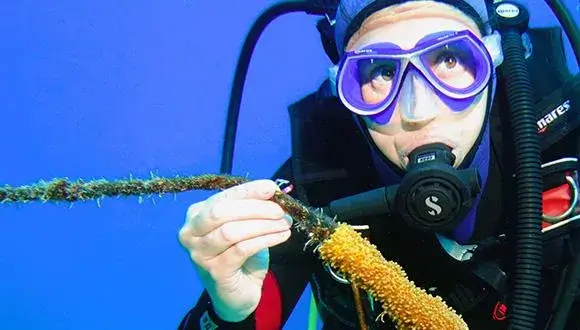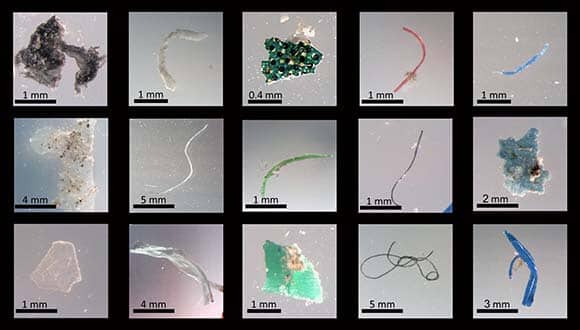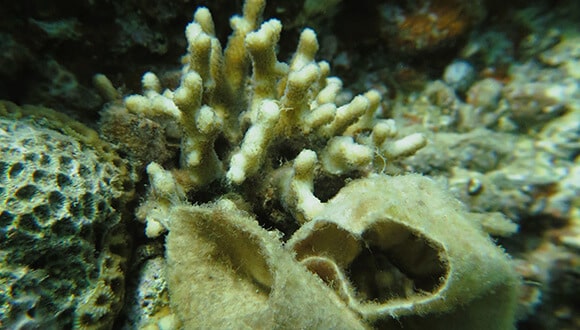The research team: "We must act quickly to continue protecting our coral reefs" * The article is dedicated to the memory of Tal Ilon, a man of the sea, the commander of the Kfar Gaza alert squad who was murdered on October 7

A study at Tel Aviv University collected extensive data on plastic pollution in the Gulf of Eilat and found that the amount of waste is low compared to coral reefs at similar sites around the world, where similar studies were carried out. According to the team of researchers, in addition to the global comparison, it was found that the pollution in the marine nature reserve in Eilat is significantly lower compared to the other sites tested, both in the concentration of visible plastic waste, and in the concentration of microplastic particles in the water. "The meaning", they say, "is that it is not too late for us, but we must act quickly to continue protecting the coral reefs in the Gulf of Eilat".
"It would be a terrible irresponsibility if the reefs in the Gulf of Eilat, which is a refuge from climate change, were to become extinct precisely because of waste"
The research was led by Gal Vared, a PhD student from the Inter-University Institute in Eilat, under the guidance of Prof. Noa Shankar from the School of Zoology at the George S. Wise Faculty of Life Sciences and from the Steinhardt Museum of Nature at Tel Aviv University. The research was published in the journal Science of the Total Environment, and contributes significantly to advancing the knowledge base for future research both in the Gulf of Eilat and in other reefs around the world.
Prof. Shankar explains: "Today it is known that the coral reefs in the Gulf of Eilat are relatively resistant to climate change, and are in good condition compared to reefs in many tropical regions of the world, which may disappear within a few decades. That is why Eilat Bay is considered a place of refuge for corals, and the reefs here are particularly important. It is our duty to take urgent steps to protect them, among other things from the threat associated with plastic waste. For this purpose, we sought to draw as comprehensive a picture as possible of the plastic pollution in the bay in all its forms, with an emphasis on the immediate environment of the coral reef."
Listen here For Prof. Shankar's podcast 'Science and Music Under Water'.
Most of the big waste: fishing and boating equipment, 70% of which is plastic waste
The comprehensive research was carried out over two years (2022-2020), in four different seasons: in the summer and fall of 2020, in the spring of 2021, and in the winter of 2022, at depths of 5 to 100 m, and at four different sites: in the northern area from the Jordanian border to the hotels, in the tourist area and near the center of Eilat , between the piers of Katsa and the marine nature reserve close to the Egyptian border.
The researchers measured three types of pollution:
- Large waste that originates from man and can be seen with the eye. This is how plastic items and other waste (wood, concrete, glass, metals, clothing, cigarettes...and more) were recorded on the seabed and on the reef itself. The items were divided into several categories: packaging (cans, bottles, etc.), items used for fishing and/or sailing, disposable items (wipes, cutlery, cups, etc.), and others - clothes, cigarettes, and more. The level of pollution was measured according to an index of the number of items per unit area.
- Microplastic particles (tiny plastic particles less than 5 mm in size), in the seawater surrounding the reefs themselves. These particles were collected using a new method in global research in the field of microplastics: divers who dragged nets near the reefs, unlike most studies that use boats, and therefore report concentrations of microplastics in the upper part of the water column, at a great distance from the reefs and the life in them. The level of microplastic pollution was measured according to an index of the number of particles per volume of sea water.
- Plastic additives (chemical substances incorporated into plastic in the production process), whose presence was tested in seawater and soil samples near the reefs. The level of pollution was measured according to indicators of concentration per volume of water and concentration per gram of sediment.

The findings revealed that most of the large waste comes from fishing and boating equipment, and 70% of it is plastic waste. In the water and soil samples, collected up to a depth of 30 m, no evidence of significant contamination from plastic additives was found. It was also found that the nature reserve site, the farthest from the city, is also the cleanest in a clear way - both from large debris visible on the bottom, and from microplastics in the water around the reefs. In addition, interactions between the waste and animals were documented: waste that covers and may suffocate animals or blocks their sunlight, waste entangled with corals, and also cases where animals use waste as shelter or as a breeding ground.
The hope is that the relative cleanliness found is not apparent
"The good news from our research is that there is probably less plastic pollution in the Gulf of Eilat compared to tropical reefs in other parts of the world," says Gal Varad and adds "however, it is important to remember that we surveyed large debris up to a depth of 100 m and the other pollutants up to a depth of 30 m. And we found significant differences between the level of pollution in shallow versus deep areas: the greater the depth, the more waste there is. This fact agrees with the findings of similar studies in other parts of the world, as well as with the topographic structure of the seabed in the Gulf of Eilat, which is very narrow and deep - up to 800 m. We hypothesize that debris that comes from the land to the shallow waters slides down the steep slope of the bay wall to a greater depth. That is, it is quite possible that the relative cleanliness we found is only an appearance (indeed, a big storm in 2020 brought to the beaches very old waste from the depths)".

Another encouraging finding noted by the researchers is that the fact that the nature reserve was found to be significantly less polluted with plastic waste compared to the other sites in the Gulf, indicates that by properly managing and preserving the environment sustainably, as is indeed done in the reserve, it is possible to protect the reef from the negative effects of plastic waste. "This way our children and grandchildren will also get to enjoy the natural treasures of Eilat's coral reef," they say.
"It is important to emphasize that the fact that the marine reserve was found to be cleaner than the other sites we examined indicates that there are applicable solutions for prevention and conservation. Mobilization and regulation, policy and strategy are needed - for the marine environment of all of us. A good example of this is the ban of the municipality of Eilat on the use of disposable utensils on the beaches. We call on the decision makers and the entire public: it's not too late! With the right conduct and management, the coral reefs of the Gulf of Eilat can be properly protected," the researchers conclude.
The article is dedicated to the memory of Tal Ilon, a man of the sea, the commander of the standby squad of Kfar Gaza who was murdered on October 7. Tal was a skipper and has a bachelor's degree in marine biology, he educated generations of sailors at the Makamorat Maritime College, 46 years old in Nefo.
More of the topic in Hayadan:
